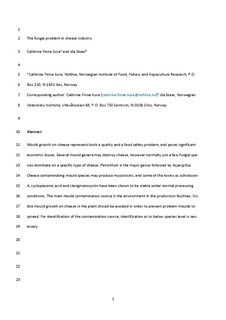| dc.contributor.author | Kure, Cathrine F. | |
| dc.contributor.author | Skaar, Ida | |
| dc.date.accessioned | 2019-10-17T09:27:15Z | |
| dc.date.available | 2019-10-17T09:27:15Z | |
| dc.date.created | 2019-09-04T10:00:39Z | |
| dc.date.issued | 2019 | |
| dc.identifier.citation | Current Opinion in Food Science. 2019, 29 14-19. | nb_NO |
| dc.identifier.issn | 2214-7993 | |
| dc.identifier.uri | http://hdl.handle.net/11250/2622733 | |
| dc.description.abstract | Mould growth on cheese represents both a quality and a food safety problem, and poses significant economic losses. Several mould genera may destroy cheese; however, normally just a few fungal species dominate on a specific type of cheese. Penicillium is the major genus followed by Aspergillus. Cheese-contaminating mould species may produce mycotoxins, and some of the toxins such as ochratoxin A, cyclopiazonic acid and sterigmatocystin have been shown to be stable under normal processing conditions. The main mould contamination source is the environment in the production facilities. Visible mould growth on cheese in the plant should be avoided in order to prevent problem moulds to spread. For identification of the contamination source, identification at or below species level is necessary. | |
| dc.language.iso | eng | nb_NO |
| dc.title | The fungal problem in cheese industry | nb_NO |
| dc.type | Journal article | nb_NO |
| dc.type | Peer reviewed | nb_NO |
| dc.description.version | acceptedVersion | |
| dc.source.pagenumber | 14-19 | nb_NO |
| dc.source.volume | 29 | nb_NO |
| dc.source.journal | Current Opinion in Food Science | nb_NO |
| dc.identifier.doi | 10.1016/j.cofs.2019.07.003 | |
| dc.identifier.cristin | 1721342 | |
| dc.relation.project | Norges forskningsråd: 262306 | nb_NO |
| dc.relation.project | Nofima AS: 201704 | nb_NO |
| cristin.unitcode | 7543,3,4,0 | |
| cristin.unitname | Trygg og holdbar mat | |
| cristin.ispublished | true | |
| cristin.fulltext | postprint | |
| cristin.qualitycode | 1 | |
